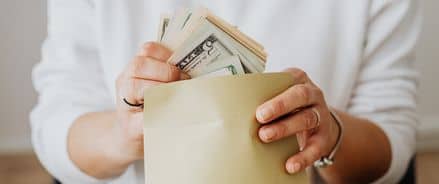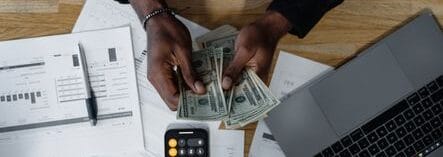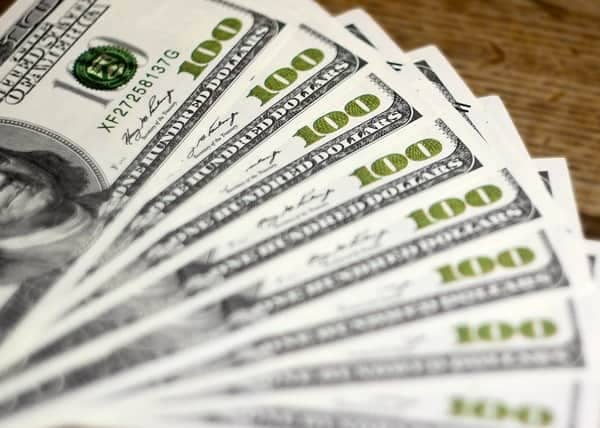All Cash Diet Guide: 3 Steps To Succeed
If you want to know what the all cash diet is or how to use it to save money then you landed on the perfect article.
We will go into everything there is to know about this method but first, let me ask you a question…
How much money did you spend on food last week? Answer quickly!
If you can’t answer that question, don’t feel bad because most people can’t. The most likely reason you can’t answer it is that you make your purchases using a debit or credit card.
Credit and debit cards make spending money on the things we want and need extremely convenient. They also tend to promote higher spending for most people.
With these payment methods, you just swipe and swipe without even realizing how much you are spending!
That’s why an all cash diet can be an incredible way to help you stick to your budget and save money.
Let’s dig deeper into this…
What Is An All Cash Diet?

An all cash diet is a budgeting method where you stop using your credit and debit cards and start using cash for all your purchases.
This reduction in cards puts your wallet into an enhanced state of savings.
Simply stated, an all cash diet means using only cash for purchases.
People have a tendency to overspend when using their cards, so eliminating the temptation and budgeting a set amount each day, week, and month helps drive better savings habits.
Now that you know what this method is, let’s talk about how it can save you money…
How A Cash Diet Saves You Money

Would you agree that swiping your debit or credit cards makes shopping more convenient? It may even feel like you’re not spending your own money.
You might not feel this way but there are research studies that prove that people tend to spend more when using credit or debit cards rather than cash. Yes, really!
Here is one research study that found that people spend more than 400% more on non-cash transactions than cash transactions.
Cash is a tangible asset, meaning it can be physically held and holds value.
When you use cash, you have to physically take it from your purse or wallet and hand it over to someone else.
You can instantly see that you have less cash than you did before. Painful right?
In fact, it is more painful to pay with cash than it is to pay with a credit or debit card.
I’m not saying we should all feel pain when making purchases but this pain of paying with cash makes you really think about if the purchase is worth it.
Think about your last few trips to the grocery store. How many times did you spend more than you budgeted for?
What if your budget shows that you shouldn’t spend more than $100 at the grocery store each week and you only bring $100 during your next visit?
You have no choice but to stick to your $100 budget!
The same could go for your next visit to a restaurant, or the shopping mall.
Really, anywhere that has some sort of discretionary spending where you could save money.
By figuring out how much you’d like to spend in these categories and limiting it by only using cash, you avoid overspending.
So, an all cash diet saves you money by making you feel the pain of spending which makes you second guess each purchase and also limits your spending to the amount of physical cash you possess.
It’s a great method to use to get your money under control so let’s dive into how to get started…
How To Start A Cash Diet

The great thing about the all cash diet is that it is super easy to get started! All you need is cash and to put your debit and credit cards to the side.
You also don’t have to stick with a permanent cash diet, you can do it for a few months to get better with money and then go back to your credit and debit cards.
The cash diet is all about taking control of your money not making your life harder!
Let’s get into 3 easy steps you can use to get started with the all cash diet…
Choose A Category

Try starting out with only one or two categories, such as grocery spending or eating out. Those are two expenses that I consistently overspend on.
Here’s a list of the most common categories that are great for a cash diet.
- Grocery Stores
- Restaurants/Eating Out
- Entertainment
- Clothing
- Home Goods
- Home Improvement
- Personal Care
Also, as mentioned earlier, don’t go into this thinking it has to last forever.
Make this a cash challenge, where you’re committed to trying it out for one week. After that, see if you can go another week.
Eventually, the goal might be to go back to using your debit and credit cards, but much more diligently than you used them before.
Determine Your Budget

Now that you know which expenses you’re looking to target, figure out how much you spend on average.
This is where you’ll have to do some digging into your personal finances.
Let’s assume you chose the grocery store and you always use your credit card when you shop there.
Look at your previous credit card statements and write down how much you spend each month.
I would suggest looking back at least 3 months. The further the better so you can get a good understanding of your average monthly spend in that category.
Here is a formula for determining your average spend:
- If you’re looking back 3 months, add up all 3 months then divide by 3.
- Month 1 + Month 2 + Month 3 = Total spend for 3 months.
- Now, divide that by 3.
This gives you your average monthly spending.
If you’re looking at 6 months, add all 6 months then divide by 6. (month 1+2+3+4+5+6)/6 = average 6-month spend.
Your goal is to save money, so just budgeting for your average spending isn’t the best idea.
I would suggest that you find a month that you spent less than what the average has been over a 3 to 6-month period.
Make sure there wasn’t a reason for spending less that month, such as a vacation.
Do you think you could spend around 10% less than you spent that month?
Don’t starve yourself or your family… just try and determine if you could manage to spend less.
For example, let’s say you’ve determined that you spend an average of $600 per month on groceries.
In month 2, you spent the least amount which totaled $510. If you try and shave off another 10% from that month, your grocery budget will be $459 each month. ($510 x 0.90 = $459).
If you go grocery shopping every week, divide your monthly budgeted amount by 4. That means your weekly grocery budget is $115.
Try only taking $115 to the grocery store the next time you visit. That way you can’t overspend.
Track Your Results

If you’re sticking to your plan, this will be the fun part!
This cash only budget for your groceries would save you $140 every month. If you can commit to this for an entire year, that’s $1,680 saved just in groceries!
The trick is to set reasonable goals that you can accomplish. You do not want to set unrealistic goals that lead to failure and quitting.
It’s important to stock this savings away into your savings account, or maybe put it towards outstanding credit card debt.
You can also invest your savings to let your money grow over time.
Just don’t go squandering this newly found money!
If you plan to put all your savings into a bank account, tracking is easy. You can see the account increase over time and know exactly how much you’ve saved.
It’s okay if the money isn’t all put into savings, just track the amount you are saving and keep a savings journal.
Seeing how much you save is a huge motivation!
Challenges

Debit and credit cards make life convenient. A quick tap here, a swipe there and you’re the proud new owner of a 75” TV!
Cash is not only inconvenient, but it’s not as safe as carrying a debit or credit card.
If you lose one of your cards, or worse, someone takes them from you, it’s not a problem. They can be easily canceled.
If you lose cash, it’s gone forever. It’s best to keep minimal amounts on you for safety concerns.
My suggestion is to make sure you’re using a bank that either has many ATMs for pulling out cash or a bank that will reimburse any ATM surcharges.
That way you can visit an ATM before you shop.
Online shopping also puts a hurdle in front of the all cash diet since you can’t use cash to shop online.
The way around this is to be extra cautious when shopping online with a debit card and if you use a credit card then make sure you pay off the balance immediately.
Conclusion
As I mentioned earlier that the all cash diet eliminates the use of debit and credit cards.
The all cash diet isn’t meant to last forever or rid you of your debit and credit cards entirely. It’s mainly aimed at saving you money on certain categories that you overspend on.
I found that going on an all cash diet was an excellent way to stick to my budget.
I might even say it’s the best option for anyone who has trouble starting or sticking to a budget.
By only bringing the amount you budget for, you have no choice but to stick to that amount. There’s no better way to enforce your budget than that!
If you liked this post then I recommend checking out my posts on Cash Envelope System For Beginners and 9 Financial Literacy Topics You Need To Learn About.
What do you think about the all cash diet? Have you tried this budgeting method before? Let me know in the comments below!






